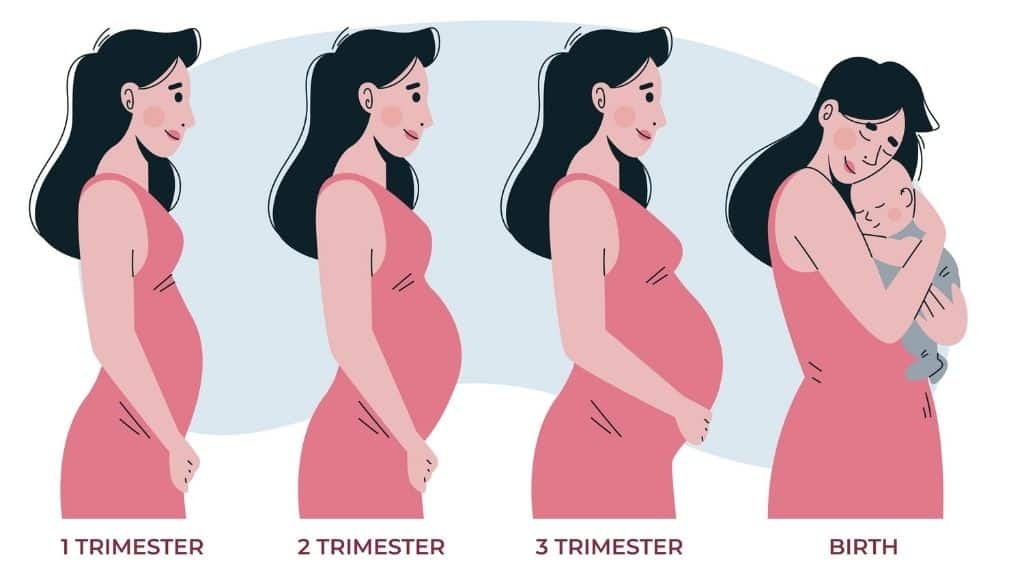
Table of Contents
From stretch marks to backaches, and cravings to nausea – the nine months of your pregnancy will be an absolute roller coaster for you! Your body changes during pregnancy as a result of hormones and as the skin and organs stretch to accommodate a growing baby. But for what it’s worth, you’ll embrace these changes as you get closer to the day you hold your little one in your arms.
Some of these changes will be obvious ones, while others will take you by surprise. So start preparing for what’s to come by understanding how the body changes during pregnancy and a list of the 10 common body changes
Understanding How Your Body Changes During Pregnancy
Women’s body changes during pregnancy. These changes can range from their digestive system to circulatory system, body weight as well as body temperature.
In order to understand how the body changes during pregnancy, we have categorized them into the following categories:
1. Hormonal Changes
Your energy and mood might be the first thing you notice before you notice many other physical changes. During the first couple of weeks in pregnancy, the hormone rush may be rather overpowering.
You may be extremely emotional, irritable, and fatigued. And of course, those hormones are a big part of your morning sickness in the first trimester.
The primary hormones that prevail throughout pregnancy are human chorionic gonadotropin (HCG), progesterone, human placental lactogen (hPL), and estrogen.
Human Chorionic Gonadotropin (HCG)
HCG is a hormone generated by the placenta. The hormone aids in the preparation and support of the body during implantation during pregnancy. It decreases during the first trimester and is thought to be the cause of nausea and morning sickness in the first trimester.
Progesterone
Progesterone is produced in large amounts during pregnancy and aids in implantation. An enlarging uterus is one of the most common women’s body changes during pregnancy as it prepares for childbirth. Progesterone helps your joints loosen up so that your body can handle these changes in your uterus.
Human Placental Lactogen (hPL)
The placenta produces another hormone, the human placental lactogen. hPL encourages the development of milk glands in your breasts, which helps you prepare for nursing.
Estrogen
Estrogen is a hormone that is generated in greater quantities in the placenta to aid in the maintenance of your pregnancy.
2. Musculoskeletal System
When you go for your first prenatal checkup, you’re gonna have to get a pelvic examination to determine if it is large enough to birth a baby.
However, nature has created a mechanism for a woman’s pelvis to gain extra space by secreting pregnancy hormones, particularly one known as relaxin, which loosens your ligaments and joints in the pelvic region.
Relaxin not only relaxes ligaments in the pelvis to prepare a woman for labor and delivery but also stretches the connective tissues throughout the body. As a result, you’re likely to have a lot of discomforts. Here are the most common ones:
- Round ligament pain
- Leg cramps
- Backaches
- Sciatica
Relaxin is also to blame for your “pregnancy waddle,” a change in posture caused by a growing belly and a curve in your spine.
3. Circulatory System
To nourish your pregnancy and your growing kid, your blood volume will grow dramatically. This implies you’ll need more iron-rich foods to avoid anemia throughout pregnancy. However, this also means that your kidneys need to work harder and your bladder’s strength will be questioned from to time.
Another common body change during pregnancy is collapsing as a result of feeling dizzy. So why does this happen? This happens because your enlarging uterus might be straining your blood vessels, and also because pregnancy can cause serious changes in your hunger and digestion.
The increase in blood flow can also cause strain in your veins, making you more likely to develop varicose veins and hemorrhoids.
Pro Tip: Keep off your feet as much as possible, eat and stay hydrated often, get up slowly from a sitting position, stay out of the sun as much as possible, and wear loosely fitted outfits.
4. Digestive System
Craving an ice cream at 11 pm? Or did your favorite chicken salad make you throw up? Usually, we tend to blame this on the hormones, but hormones aren’t the only factor affecting how your body processes and manages food during pregnancy. Your digestive system will also undergo significant alterations.
As you approach the third trimester and your developing baby presses on your stomach, you can experience an increase in heartburn and reflux.
Pro Tip: You can discuss pregnancy-safe antacids and other medications with your doctor to alleviate some of the most unpleasant stomach issues. Also, it may be beneficial to eat smaller, more frequent meals.
5. Oral Health And Smell
During pregnancy, women’s immune systems are weakened, making them more susceptible to illnesses. Gum bleeding is a typical pregnancy problem, and it can open the door to infections. Healthcare specialists suggest that it is critical to maintaining good dental hygiene to avoid gum inflammation or gingivitis.
Another noticeable change that you might notice during this time is that you’ve magically turned into a bloodhound, and are able to detect pleasantly (and unpleasant) smells even from a significant distance.
Experts believe that these alterations are protective changes, as your senses are protecting you from swallowing anything that may make you sick or jeopardize the fetus.
6. Hair, Skin, And Nails
Now finally coming to the body changes during pregnancy that you’ll be happy about (and a few, not so much)!
Hair Growth
During this time, estrogen boosts the duration of the hair follicles’ development period, resulting in a thicker, healthier mane of hair.
However, this also means that sometimes you’ll have hair in undesirable locations including your back, stomach, upper lips as well as around nipples.
Pregnancy Glow And Skin Concerns
You’ll notice the next pleasant changes in your skin. Pregnancy glow is most likely to occur due to hormonal changes and increased blood flow makes your skin look rosy.
But there are a few skin concerns that one must be prepared for during pregnancy:
- Nipples getting darker
- A visible dark line that runs down the front of your abdomen is called linea nigra
- Dark spots of skin on the face called melasma
- Stretch marks on your abdomen, buttocks, and thighs
Brittle Nails
According to The American College of Obstetricians and Gynecologists (ACOG), the texture of nails coarsens during pregnancy, making them more delicate and fragile, and they may split more readily. This happens due to the increase in estrogen levels in your body.
Pro Tip: Get your manicure and pedicure done a week before your estimated delivery date.
7. Body Temperature & Body Weight
The heightened metabolic rate and sweat gland activity can make you feel warmer and you might be sweating more. Apart from your body temperature, the other obvious thing that will go up is your body weight.
You can expect a weight gain of 25 to 35 pounds, the majority of which will occur during the second and the third trimester of pregnancy. Since your cravings and appetite are most likely to increase during this time, you will have little to no control over your weight gain.
In the third trimester, however, the weight gain is caused by water retention and not your diet. This can result in swelling of your face, hands, and feet.
Pro Tip: Put your feet up, rest, and stay cool and hydrated — this soreness too, shall pass!
8. Breasts, Uterus, And Cervix
Your breasts may seem fuller and softer, and your nipples may be more sensitive to touch.
Toward the first few weeks of pregnancy, the areolas might look dark. In addition, colostrum, a milky fluid, may begin to flow from a woman’s breasts. Even though this occurs in the third trimester, it can also happen sooner.
Pro Tip: For added support, you can choose to sleep in a maternity bra.
9. Belly Button
Your belly button tends to pop out as a woman’s abdomen swells late in the second or early in the third trimester.
One of the most visible body changes during pregnancy is the linea nigra. The linea nigra is a line that runs down your lower abdomen – from your belly button to your pubic hairline. This is very common and will disappear when the baby is born.
10. Feet
Although it is rare, your feet can swell a whole shoe size during pregnancy. This might be due to an increase in growth hormones. A few studies have verified that pregnant women’s feet get larger and that the arches of their feet flatten down.
Swelling in the feet and ankles can also develop when the body produces too much fluid, which can pool in these two areas.
Summarizing The Body Changes During Pregnancy Week By Week
Now that we have read about the 10 most common women’s body changes during pregnancy, let’s take a look at body changes during pregnancy week by week:
Week 1 to 4
- Cramps in your lower abdomen
- Optional spotting
- Missed periods
Week 5 to 8
Week 9 to 12
- Weight gain
- Acne
- Pregnancy glow
- Round ligament pain
Week 13 to 16
- Increased appetite
- Sensitive gums
- Leg cramps
Week 17 to 20
- Backache
- Pregnancy brain
- Hand and feet swelling
- Varicose vein
Week 21 to 24
- Body pain
- Fast hair and nail growth
- Belly button popping out
Week 25 to 28
- Carpal tunnel syndrome.
- Hemorrhoids
- Disturbed sleep
Week 29 to 32
- Growing stretch marks
- Fluid from breasts
- Braxton Hicks contractions
Week 33 to 36
- Pelvic pain
- Fetal movement
Week 37 to 42
- Spotting
- Abdominal pressure
- Signs of labor
Body Changes During pregnancy Final Conclusion
It is astonishing how your body changes during pregnancy. Most of the body changes during pregnancy are tiring and painful. However, you must remember that these physical changes, particularly the more unpleasant ones, are only temporary.
Almost all of these changes vanish after delivering within a couple of days or weeks. And, as unpleasant, nauseous, painful, and plain inconvenient as some of these changes may be, bear in mind that they are all taking place in the name of assisting in bringing your kid into this world.









